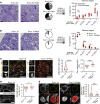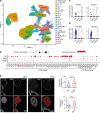Loss of genome maintenance is linked to mTOR complex 1 signaling and accelerates podocyte damage
- PMID: 40392611
- PMCID: PMC12220965
- DOI: 10.1172/jci.insight.172370
Loss of genome maintenance is linked to mTOR complex 1 signaling and accelerates podocyte damage
Abstract
DNA repair is essential for preserving genome integrity. Podocytes, postmitotic epithelial cells of the kidney filtration unit, bear limited regenerative capacity, yet their survival is indispensable for kidney health. Podocyte loss is a hallmark of the aging process and of many diseases, but the underlying factors remain unclear. We investigated the consequences of DNA damage in a podocyte-specific knockout mouse model for DNA excision repair protein Ercc1 and in cultured podocytes under genomic stress. Furthermore, we characterized DNA damage-related alterations in mouse and human renal tissue of different ages and patients with minimal change disease and focal segmental glomerulosclerosis. Ercc1 knockout resulted in accumulation of DNA damage and ensuing albuminuria and kidney disease. Podocytes reacted to genomic stress by activating mTOR complex 1 (mTORC1) signaling in vitro and in vivo. This was abrogated by inhibiting DNA damage signaling through DNA-dependent protein kinase (DNA-PK) and ataxia teleangiectasia mutated (ATM) kinases, and inhibition of mTORC1 modulated the development of glomerulosclerosis. Perturbed DNA repair gene expression and genomic stress in podocytes were also detected in focal segmental glomerulosclerosis. Beyond that, DNA damage signaling occurred in podocytes of healthy aging mice and humans. We provide evidence that genome maintenance in podocytes is linked to the mTORC1 pathway and is involved in the aging process as well as the development of glomerulosclerosis.
Keywords: Aging; Cell biology; Chronic kidney disease; DNA repair; Nephrology.
Conflict of interest statement
Figures







Similar articles
-
Podocyte YAP ablation decreases podocyte adhesion and exacerbates FSGS progression through α3β1 integrin.J Pathol. 2025 Jan;265(1):84-98. doi: 10.1002/path.6370. J Pathol. 2025. PMID: 39668547
-
Podocyte-derived soluble RARRES1 drives kidney disease progression through direct podocyte and proximal tubular injury.Kidney Int. 2024 Jul;106(1):50-66. doi: 10.1016/j.kint.2024.04.011. Epub 2024 Apr 30. Kidney Int. 2024. PMID: 38697478 Free PMC article.
-
Nephrin is necessary for podocyte recovery following injury in an adult mature glomerulus.PLoS One. 2018 Jun 20;13(6):e0198013. doi: 10.1371/journal.pone.0198013. eCollection 2018. PLoS One. 2018. PMID: 29924795 Free PMC article.
-
Revisiting nephrin signaling and its specialized effects on the uniquely adaptable podocyte.Biochem J. 2025 Jun 2;482(11):763-88. doi: 10.1042/BCJ20230234. Biochem J. 2025. PMID: 40457651 Free PMC article. Review.
-
The Life of a Kidney Podocyte.Acta Physiol (Oxf). 2025 Aug;241(8):e70081. doi: 10.1111/apha.70081. Acta Physiol (Oxf). 2025. PMID: 40698593 Free PMC article. Review.
References
MeSH terms
Substances
Grants and funding
LinkOut - more resources
Full Text Sources
Research Materials
Miscellaneous

